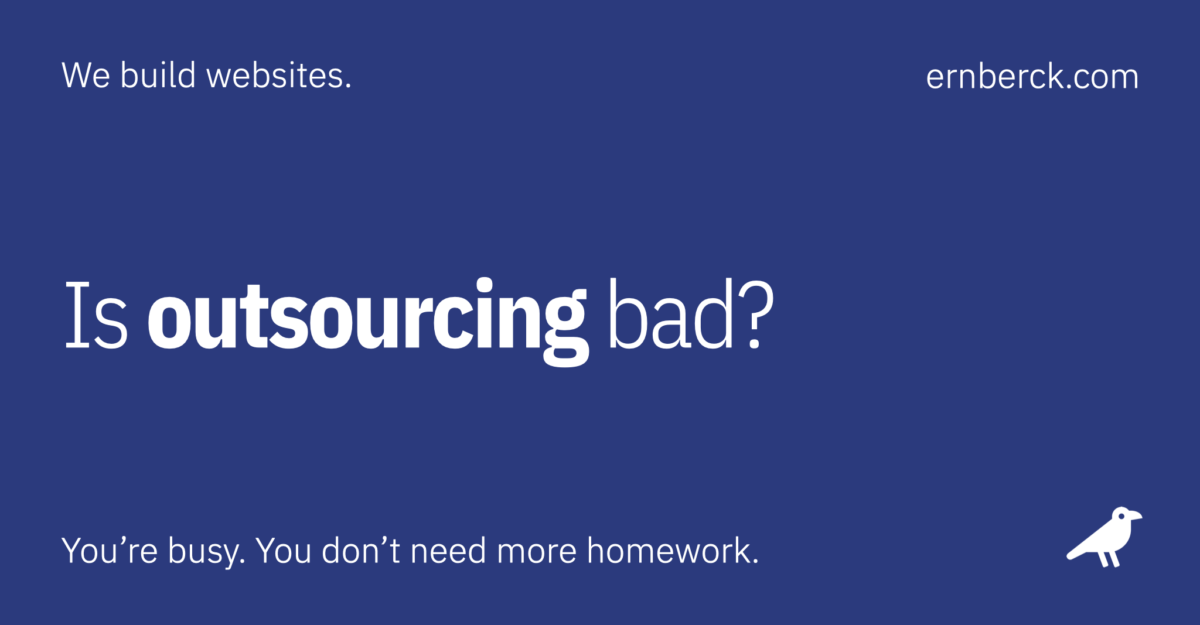You may not know it, but a lot of marketing agencies outsource most of their website design work to inexpensive overseas freelancers. You’re entitled to know who will be doing the actual work, and where they’re located.
Outsourcing is common
Probably much more common than you think. That’s not necessarily a bad thing, but there just seems to be so much of it going on these days. From virtual assistants (VAs), to programming, design, copywriting, and everything in between.
Plus, with the recent explosion of cheap AI-based (artificial intelligence) content creation tools, outsourcing is going to become even more prevalent.
If you’re a small business looking for creative or marketing services, please be aware of the landscape in which you’re now operating. We think you have a right to know who will actually be doing your work, and where they’re located.
What is outsourcing?
To “outsource” is to obtain goods or services from an outside or foreign supplier, especially in place of an internal source. This often includes contracting for labor and services from other countries. Outsourcing is typically done to reduce costs, or to access skills not available elsewhere.
More profit
The primary reason for outsourcing is to increase the bottom line. For instance, the hourly cost of a competent graphic designer in the United States might be $50 to $100 per hour. The equivalent services, say in the Philippines, might be had for $10 to $20 per hour (or less).
As an agency providing design work to a client, this would dramatically decrease your cost of services sold — with a similar increase in profits. The globalization of online commerce and communication has pretty much eliminated any significant barriers to such long-distance arrangements.
Marketing agencies
A common example of outsourcing would be a marketing agency that contracts work out to another vendor. There’s nothing inherently wrong with this practice as long as it’s divulged to the client. Regrettably, it often isn’t and some agencies outsource everything, including:
- Graphic design
- Web design
- Web development
- Copywriting
- Photo sourcing
- Lead generation
- Programming
- Hosting
- Search engine optimization (SEO)
- Media buying
- Social media management
- Email marketing
- Technical support
- Event management
To be fair, I should point out that outsourcing is in the very nature of agencies — It’s in their DNA. Agencies are most often established to provide a particular service, typically one that involves organizing transactions between two other parties. Also, it can be in the client’s best interest if the most effective solution is also the most economical.
Outsourcing downsides
Unfortunately, the outsourcing system can lead to big gaps in the agency’s knowledge and expertise. Since they’re not deeply involved in these processes on a daily basis, they may not be aware of technology or regulatory changes that can drastically impact an industry overnight.
Also, many foreign vendors aren’t familiar with U.S. laws, customs, or standards. This can lead to adverse management and legal issues, including:
- Loss of control
- Lack of quality
- Security risks
- Fraudulent practices
- Payment issues
- Public backlash
- Time zone hassles
- Language barriers
- Privacy regulations
- Accessibility problems
Shared content
Outsourcing can have other negative consequences too. Consider the following example:
A former client of mine outsourced her email newsletter to a popular copywriting firm in the UK. Her subscribers loved the content, eagerly shared it with friends, and a big increase in subscriptions followed.
Then one day she began receiving complaints from baffled subscribers. Apparently they had received the identical newsletter from two other firms. Oops.
Though this possibility was disclosed in the contract (which she didn’t read), it never occurred to her that the copywriter was selling the same newsletter to dozens of companies.
To make matters worse, it seems that some of the newsletter purchasers were using the content for public blog articles — A practice expressly forbidden in the contract.
White labeling
Something else to watch out for is white labeling. A “white label” product or service is a commodity created by one company, that sells it to other companies, who in turn rebrand it to make it appear as if they had made it themselves.
In other words, white label products are sold by vendors with their own trademark, but the products themselves are manufactured by a third party. Like outsourcing, there’s nothing essentially wrong with this practice as long as the client is aware of it.
Summary
You may not know it, but a lot of marketing and design agencies outsource much — if not all — of their web design and development work. Often to inexpensive overseas freelancers. That’s okay, but when you hire a design studio or agency I think that there’s an expectation that the work will be done in-house. Again, you’re entitled to know who will be doing the actual work, and where they’re located.
